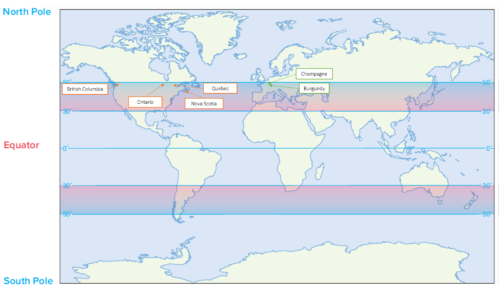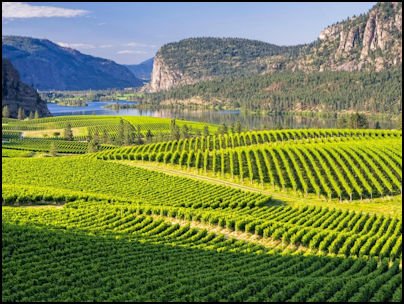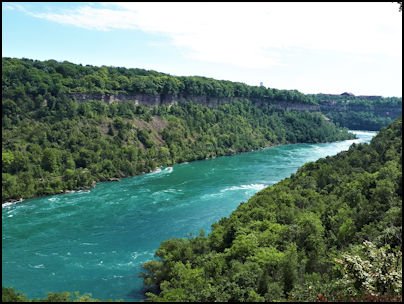Canada is not the first country to come to mind when considering wine-growing areas. However, Canada’s wine region is positioned within the recognized growing zones between 30 and 50 degrees latitude, a range shared by many other cool-climate wine regions of Europe like Champagne and Burgundy in France.
Canada has four distinct wine regions around British Columbia, Ontario, Quebec and Nova Scotia.
The primary wine-producing areas include the Okanagan Valley in southern British Columbia and the Niagara Peninsula in southern Ontario.
The Okanagan Valley is one of Canada’s premier wine regions. It benefits from a semi-arid climate, with warm summers and mild winters, making it well-suited for grape cultivation. The valley is known for producing a wide range of grape varieties, including Chardonnay, Pinot Noir, Merlot, Cabernet Sauvignon and Riesling. Kelowna and Penticton are two of the main towns within the Okanagan Valley known for their wineries and vineyards.
Canada’s largest wine-producing region by volume is Niagara Peninsula. This region benefits from a moderate climate, assisted by the Great Lakes, particularly Lake Ontario. This allows for the production of a diverse range of grape varieties, including Chardonnay, Riesling, Cabernet Franc and Icewine. Niagara-on-the-Lake and St. Catharines are key towns within the Niagara Peninsula known for their wineries and vineyards.
Located on the northern shores of Lake Ontario, Prince Edward County is a relatively young but rapidly growing wine region in Ontario. Its cooler climate and limestone-rich soil make it well-suited for producing crisp white wines, Pinot Noir and Chardonnay. The region has gained recognition for its quality wines and picturesque vineyard landscapes.
Nova Scotia, on Canada’s east coast, has also emerged as a notable wine region in recent years. The Annapolis Valley, in particular, is known for its cool climate and maritime influences, which contribute to the production of aromatic white wines and sparkling wines. Grape varieties such as L’Acadie Blanc, Seyval Blanc, and Pinot Noir are commonly grown in this region.
Last but by no means least, Quebec‘s wine industry is centred primarily in the Eastern Townships region, located in the southern part of the province. Despite its colder climate, Quebec has been producing wine for several decades, focusing on cold-hardy grape varieties such as Frontenac, Marquette, and Vidal. The region is also known for its production of Icewine.
Despite their comparatively modest size on the global scale, Canada’s wine industry is experiencing significant growth, with wineries emerging wherever soil and climate conditions allow for cultivating productive vines. Regions like the Similkameen Valley adjacent to the Okanagan Valley in British Columbia and Lake Erie North Shore in Ontario have notably flourished, contributing to a renaissance in the Canadian wine industry over recent decades. In total, Canada’s wine-growing regions encompass 31,001 acres (12,565 hectares) and are home to over 600 wineries.
The country’s cold climate presents challenges for growing grapes, particularly in regions with harsh winters. However, advancements in viticulture techniques and the development of cold-hardy grape varieties have enabled Canadian winemakers to overcome these challenges and produce high-quality wines.
Click here to search for Canadian wineries, or use the Watt Wines map below to zoom in and explore these unique regions.
Wineries around the country
Click here to find out more about the wineries in this region and to search for specific criteria.
Top Stats of Canadian Wineries
Regions
12 official DVAs
Wineries
approx 600
Crush
118,000 tonnes
Vine Area
12,565 hectares
Source: winesofcanada.ca
Regions
British Columbia wine region, particularly the Okanagan Valley, is renowned for stunning landscapes and exceptional wines. With its diverse terroir and microclimates, British Columbia is becoming a key player in the global wine industry.
Ontario wine region is centred around the Niagara Peninsula. From Lake Ontario’s shores to Prince Edward County’s picturesque vineyards, Ontario’s winemakers craft a diverse array of wines, from elegant Chardonnays to robust Cabernet Francs.
Nova Scotia’s wine region is nestled along the scenic shores of the Atlantic. From the rolling hills of the Annapolis Valley to the coastal breezes of the South Shore, winemakers harness the unique maritime climate to produce wines of exceptional character.

Quebec
Quebec’s wine region, where French heritage meets Canadian terroir. From the picturesque landscapes of the Eastern Townships to the fertile soils of Montérégie, Quebec’s winemakers craft an array of unique and expressive wines.






